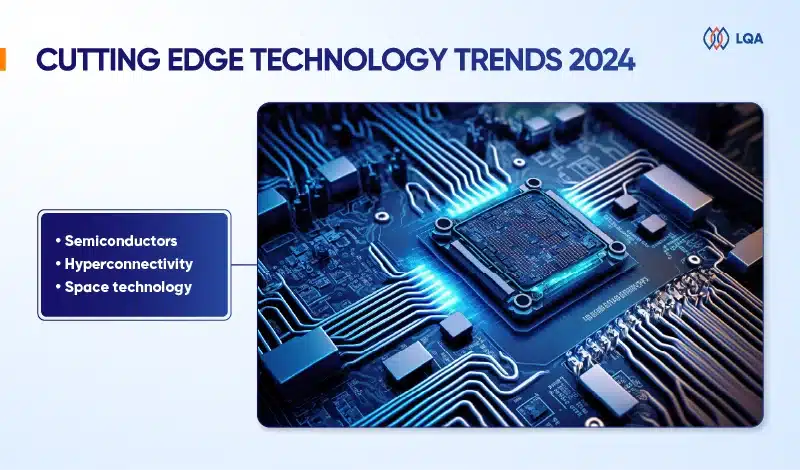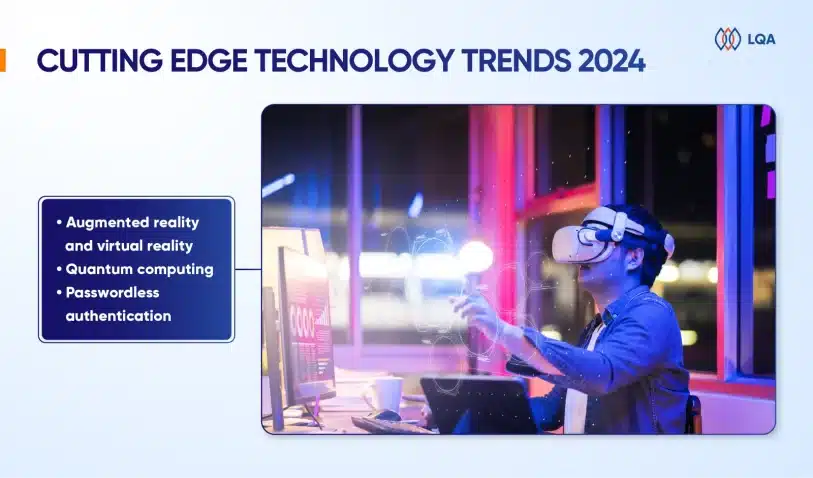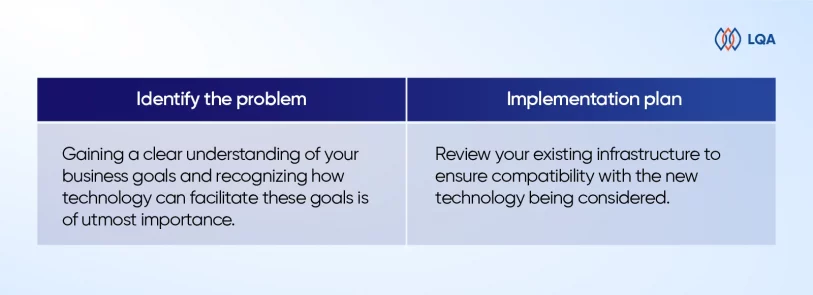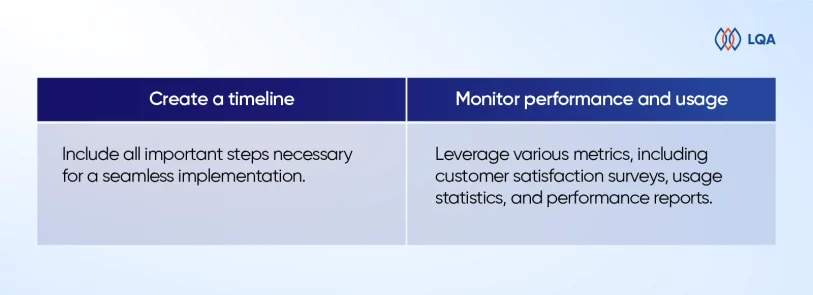Cutting edge technology is evolving at an unprecedented pace, reshaping how we live, work, and connect. In this rapidly changing landscape, it’s not just the tools that are advancing but also the roles and responsibilities of IT professionals.
Utilizing cutting edge technology brings substantial advantages, including enhanced performance, increased efficiency, access to novel and advanced features, and a competitive edge in the market.
In this article, let’s delve into a comprehensive overview of advanced technologies in 2025 in development and the exciting possibilities they offer to users.
What Is Cutting Edge Technology?
Cutting edge technology (or leading-edge or state-of-the-art technology), is the latest and most advanced solutions, machines, devices, services, techniques, or achievements that leverage current and top-level IT developments.
Embracing new cutting edge technology enables pioneering organizations in the IT industry to make notable breakthroughs in business, technology, and programming.
The Importance of Cutting Edge Technology
Cutting edge technology holds immense importance as it can bring substantial enhancements to our existing technology and processes. Any technology widely prevalent today, such as solar panels, was once classified as cutting edge technology before undergoing extensive testing and widespread adoption.
In today’s context, cutting edge tech has become even more indispensable, particularly due to the significance of data collection. The ability to gather, process, and harness vast quantities of data often serves as a driving force behind the growth of the latest technologies.
Furthermore, this data-driven approach can unlock further advancements in technology, making them more exceptional once they are widely embraced.
Cutting Edge Technology: Trends That Reshape The World In 2025
Let’s explore a few domains of cutting edge technology in today’s world that will introduce remarkable innovations soon.
Agentic AI
Agentic AI is the next leap in artificial intelligence – where systems not only interpret data but also make decisions and take action independently. Unlike traditional AI applications such as speech recognition, game-playing, or AI-powered chatbot on websites, agentic AI systems are goal-driven and capable of initiating tasks without human intervention. They understand context, collaborate with other digital agents, and can dynamically respond to changing inputs or environments.
According to Gartner, by 2028, at least 15% of all work-related decisions will be made autonomously by agentic AI systems, up from virtually 0% in 2024.
Through the power of artificial intelligence, machines strive to mimic human cognition and augment it in more autonomous and impactful ways, paving the way for transformative advancements in various domains.
>> Don’t miss:
- AI-powered virtual assistant: Huge market size from simple voice annotation
- How to make an AI from scratch?
Quantum computing
Quantum computing represents a captivating field that transcends multiple disciplines, including computer science, physics, and mathematics. It harnesses the principles of quantum mechanics to tackle intricate problems with unprecedented speed, surpassing the capabilities of classical computers.
Within the realm of quantum computing, researchers explore cutting-edge hardware advancements while simultaneously delving into the development of practical applications for this transformative technology.
By leveraging the power of probabilities instead of binary systems, quantum computers can accommodate significantly larger datasets, enabling them to perform extensive computations and yield highly accurate results.
The implications of this advancement extend across various industries, specifically those reliant on rapid data processing. Moreover, quantum computing proves invaluable for devices that require efficient data processing, as it enhances their overall efficiency while significantly reducing calculation time.
Semiconductors
A semiconductor refers to a material possessing distinct electrical characteristics that form the fundamental building blocks for computers and various electronic devices. Typically, it manifests as a solid chemical element or compound capable of conducting electricity under specific conditions, while impeding its flow under others.
By leveraging advanced materials, devices can accommodate a greater number of semiconductors, thereby significantly enhancing their capabilities and functionalities.
Post-quantum cryptography (PQC)
Quantum computing promises unprecedented computational power, but it also threatens current cryptographic standards. Post-quantum cryptography involves developing encryption methods resistant to quantum attacks, ensuring data security in a post-quantum world.
Designed for long-term resilience, PQC algorithms aim to protect data well into the future – particularly in high-stakes sectors like banking, healthcare, and national defense.
Hyperconnectivity
This cutting edge technology is exemplified by the seamless interconnection of our devices, such as smart devices, and the effortless access to information, such as browsing the internet via our smartphones.
Space technology
Space technology is an array of hardware, equipment, and systems employed in the pursuit of space exploration and development. It includes not only the tangible tools utilized but also the intricate web of technologies and processes that facilitate their operation and maintenance.
The impact of space technology extends beyond its immediate applications. Many groundbreaking material advancements we witness today, particularly in communication devices, owe their existence to space exploration.
Homomorphic encryption
Homomorphic encryption builds upon the foundations of public key encryption systems, employing a unique approach. In this case, a single public key and a corresponding private key are utilized to perform the intricate tasks of encrypting and decrypting data.
This cutting edge innovation holds immense potential in securing data in cloud environments, facilitating faster and more efficient data processing and interaction. What makes homomorphic encryption particularly crucial is its ability to maintain data security while simultaneously providing users with the necessary flexibility to interact with it.
3D sensor
A 3D sensor represents an advanced device to gauge the distance or orientation of an object in three-dimensional space, employing the principles of depth perception.
The underlying technology behind 3D sensing revolves around the projection of light waves toward a target object and subsequently capturing the reflected waves to ascertain the object’s shape and position.
Robotics
Robotics includes a dynamic realm of technology focused on the intricate aspects of designing, constructing, operating, and utilizing robots.
It extends beyond the physical realm and encompasses the development of sophisticated computer systems responsible for controlling these robots, providing sensory feedback, and engaging in intricate information-processing tasks.
The field of robotics is on the verge of entering the mainstream. Although there has been considerable buzz surrounding robotics for some time, it is only now that various hardware and software technologies have reached a level of maturity.
With recent advances in hardware and AI, robotics is moving from labs into real-world applications. One notable example is robotaxis – autonomous vehicles that navigate and transport passengers without human drivers. By combining robotics, computer vision, and machine learning, robotaxis are driving the future of mobility and showing how robotics can integrate into everyday life.
IoT, 5G and edge computing
The convergence of 5G network technology and edge computing gives rise to the transformative concept known as 5G edge computing.
This innovative fusion combines the remarkable capabilities of high-speed network technology with decentralized computational power, fostering a landscape where operational efficiency is heightened, and data-driven adaptations can unfold with remarkable speed.
On a distinct note, the Internet of Things (IoT) represents a comprehensive framework encompassing an intricate network of physical objects, aptly referred to as “things.”
The most compelling application of IoT lies in its capability to enhance human interaction with the surrounding environment. The majority of advancements in this realm concentrate heavily on user convenience, enabling individuals to engage more seamlessly with their devices.
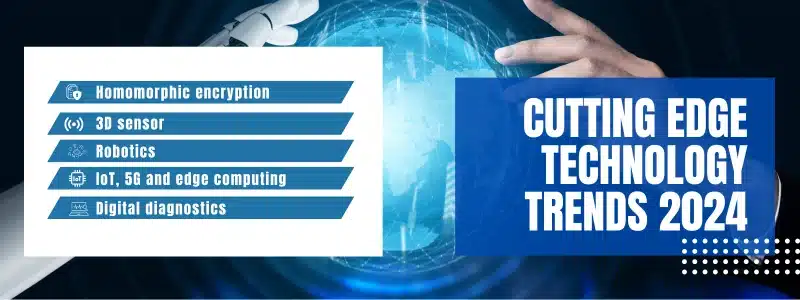
Digital diagnostics
Digital diagnostics include the use of digital technology and robust networking infrastructure to seamlessly integrate different aspects of healthcare.
This progressive approach encompasses telehealth consultations, AI-powered diagnostic tools, electronic health records, and advanced lab processing capabilities, fostering a cohesive and efficient diagnostic process.
We can anticipate a surge of innovation and activity in the coming years, focused on enhancing the real-time diagnostic capabilities of virtual healthcare. This progress will continue to diminish the reliance on in-person visits, making healthcare more accessible and convenient for all.
Augmented reality and virtual reality
Augmented Reality (AR) and Virtual Reality (VR) offer distinct experiences. AR seamlessly merges virtual elements into the real world, allowing users to maintain control over their presence.
In contrast, VR immerses users in a fully virtual environment, where system controls dictate their experience. VR necessitates a headset device, while AR can be accessed through smartphones.
Passwordless authentication
Passwordless authentication revolutionizes the way user identity is verified by eliminating the need for traditional passwords. Instead, it embraces highly secure alternatives such as possession factors, including one-time passwords (OTP) and registered smartphones, along with advanced biometric measures like fingerprint and retina scans.
By adopting passwordless authentication, users can enjoy enhanced security without the burden of managing and remembering passwords.
Passwords have been the go-to method for safeguarding data and information security over the years. Although they are effective, they also come with inherent vulnerabilities when facing increasingly sophisticated attacks.
Consequently, alternative approaches such as biometric data or passkeys have emerged to address the limitations of password-based systems. These alternatives can render passwords obsolete altogether as they keep developing and gaining traction over time.
Nanotechnology
Nanotechnology embodies the remarkable ability to comprehend, measure, manipulate, and construct materials at the incredibly minute scale of atoms and molecules, known as the nanometer scale.
Its influence extends far and wide, permeating numerous scientific and practical domains, ranging from healthcare and agriculture to electronic devices, computer science, and beyond. The profound impact of nanotechnology resonates throughout a diverse array of fields, fueling innovation and unlocking unprecedented possibilities.
Nanotechnology improves the density of memory chips. It also reduces the size of transistors used in integrated circuits. Nanotechnology improves display panels on electrical gadgets. This results in lower power usage, less weight, and thinner screens.
Next gen computing
The next generation of technology showcases a remarkable range of advancements, including advanced robotics, AI, IoT, RPA, quantum computing, 3-D printing, 5G wireless networks, VR and AR, and blockchain. These transformative technologies redefine possibilities and shape the future.
Next-generation computing stands at the forefront of transforming the way individuals engage with data. Notably, there has been a significant drive towards advancing encryption techniques as a means to enhance the protection of personal data against cyber threats.
Prominent examples include the deployment of elliptic curve cryptography to fortify the security of public communications, or the utilization of virtual machines to enable the operation of multiple computers from a single device.
Cloud computing
At its core, cloud computing represents a streamlined approach to accessing and utilizing a wide range of computing services. These services are servers, storage, databases, networking, software, analytics, and intelligence, all conveniently delivered over the internet, commonly referred to as “the cloud.”
By leveraging cloud computing, businesses and individuals can unlock accelerated innovation, flexible resource allocation, and cost efficiencies on a significant scale.
Sustainable technology
Sustainable technology, also known as green technology, focuses on developing innovations that minimize environmental impact while supporting long-term economic growth. These technologies span renewable energy, energy efficiency, smart waste management, and sustainable resource use, enabling organizations to align with Corporate Social Responsibility (CSR) goals and meet tightening regulatory standards.
Hyperscalers are investing in solar-powered data centers, liquid cooling systems, and even nuclear microgrids to handle the rising demands of AI in a more sustainable way. On the software side, AI workloads are being optimized to reduce emissions, while real-time carbon tracking tools help companies monitor and meet Environmental, Social, and Governance (ESG) goals.
The global green technology and sustainability market was valued at $14.3 billion in 2022 and is expected to grow at a CAGR of over 19.5% between 2023 and 2032. This momentum is fueled by growing environmental awareness and the urgent need for businesses to adopt more sustainable practices.
> Read more: Top 13 technology trends in 2023 that are shaping the future
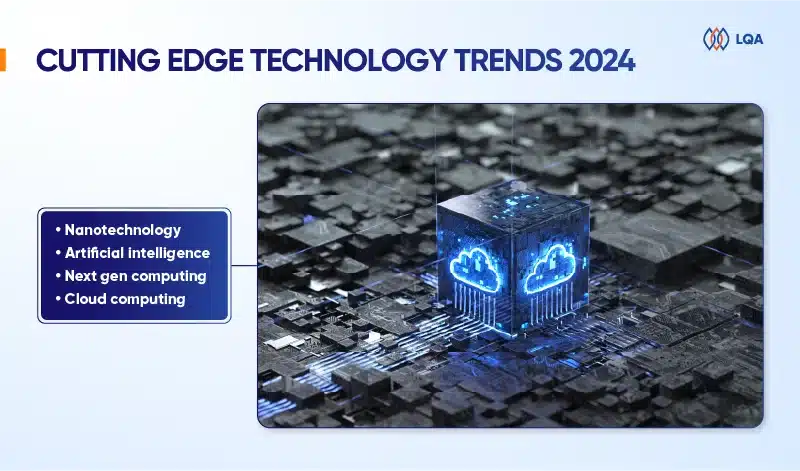
The Importance of Cutting Edge Technology
Leveraging cutting-edge technologies can yield significant competitive advantages for businesses. By staying at the forefront of technological advancements, companies can differentiate themselves and offer their customers innovative and distinct solutions.
Let’s explore some advantages of cutting edge technologies:
Embracing the latest digital advancements
Incorporating the latest advancements in technology brings forth a realm of captivating possibilities for organizations to enhance their digital capabilities.
By harnessing new technologies, businesses can create compelling differentiators, enhance their current suite of products and services, and introduce cutting edge solutions to gain a decisive competitive advantage.
In today’s digital landscape, equipping oneself with a powerful arsenal of state-of-the-art technologies can be the differentiating factor between triumph and failure in the business realm.
Enhanced operational effectiveness
Cutting edge technologies are meticulously crafted to deliver optimal, reliable, and expedited solutions to both emerging and persistent challenges. For businesses, embracing these new technologies equates to achieving more with less – in other words, bolstered efficiency.
One notable example of enhancing business efficiency is robotic process automation (RPA). By automating routine business processes using AI-driven tools, there are several noteworthy advantages.
These include significant time savings on repetitive tasks, heightened productivity, eradication of human errors, and an overall improvement in business agility.
Gaining a cutting edge advantage
As highlighted in the recent KPMG 2022 CEO Outlook survey, business leaders recognize the critical importance of aligning investments with growth.
A staggering, 70% of CEOs express the need for heightened agility to redirect investments towards digital opportunities while divesting from areas susceptible to digital obsolescence.
An impressive 72% of CEOs reveal their commitment to an assertive digital investment strategy, driven by the relentless pursuit of staying at the forefront of the technological race.
These astute leaders comprehend the immense competitive advantage bestowed upon early adopters of technology within the business landscape.
Streamlined IT expenditures
An optimized digital and operational infrastructure inherently translates into diminished financial burdens. By embracing state-of-the-art technology, you can reap substantial savings on operational expenses.
Furthermore, technology vendors frequently extend financial incentives to those who are early adopters, allowing businesses to secure cost-effective hardware and software solutions right from the outset.
What Are The Drawbacks of Cutting Edge Innovation?
Now that the notion of embracing cutting edge technology has sparked their interest, let’s take a moment to pause and reflect some cutting edge technology cons.
Things break
This is the primary challenge of cutting edge technology. Due to its limited track record, this type of technology might encounter an undesirable outcome – it breaks.
Imagine that businesses have just implemented a state-of-the-art software stack into your pipeline, one that holds the promise of transforming the company’s operations. Initially, everything runs flawlessly, and they are filled with anticipation.
However, out of nowhere, the technology suddenly fails. As a result, your business processes may come to a screeching halt, causing significant disruption.
Considering the potential consequences, can companies truly afford to endure such a level of risk in their production systems? Unlikely!
Less support
Simultaneously, when such issues arise and cutting edge technology breaks, enterprises may discover that the support available is significantly limited. The company responsible for developing that innovative technology might not have sufficient time to create comprehensive support documentation.
Additionally, due to its novelty, other businesses likely don’t have the opportunity to deploy and share their experiences or report any problems they encountered. Consequently, businesses may find yourself with limited options for seeking assistance, and even if help is accessible, it may not be as effective or beneficial as they expect.
No future proof
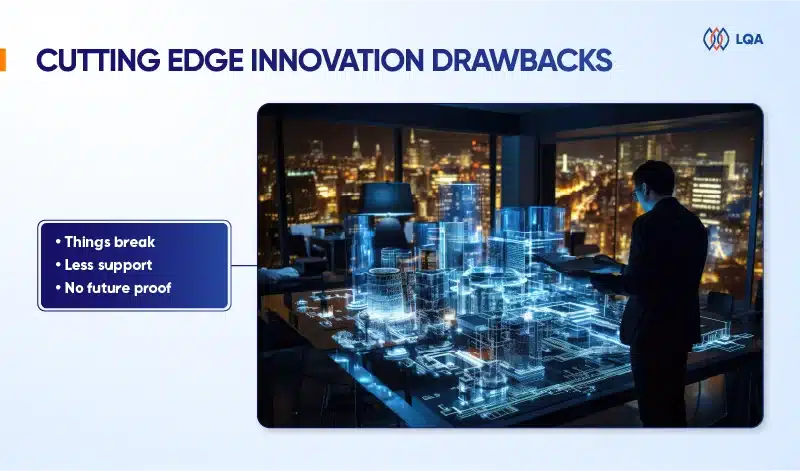
Lastly, and this aspect cannot be emphasized enough, no guarantee cutting edge software development will endure.
Despite being presented with enticing promises from the developing company regarding the prospects of this new software stack, there is always the possibility that the company may cease operations after six months or a year of usage or opt to shift away from their original vision.
In such circumstances, companies could find themselves right back where they started, facing the need to explore alternative solutions.
How to Adopt Advanced Technologies Without Risks?
To successfully embrace and integrate these new technologies, businesses should comprehend the process of implementation. Below are some pieces of advice to help businesses adopt new cutting edge technologies smoothly without risks.
Identify the problem
Gaining a clear understanding of your business goals and recognizing how technology can facilitate these goals is of utmost importance. Once companies have identified your goals, it’s time to embark on thorough research to explore the array of available technologies that can effectively assist you in attaining those objectives.
Implementation plan
This entails evaluating the costs involved in applying the technology, as well as carefully considering any potential risks associated with its adoption. Enterprises should review your existing infrastructure to ensure compatibility with the new technology being considered.
Furthermore, a comprehensive understanding of the training and support requirements associated with the new technology is vital for a successful integration process.
Create a timeline for implementation
The timeline should have all the important steps necessary for seamless implementation, including rigorous testing and inclusive training. Throughout this process, businesses should maintain open lines of communication, ensuring that all stakeholders are well-informed about the progress of the implementation.
Moreover, organizations should also regular updates on any challenges or impediments encountered along the way to keep everyone involved well-informed.
Monitor performance and usage
Lastly, once the technology has been implemented and thoroughly tested, companies have to monitor its performance and usage closely. You can do this by leveraging various metrics, including customer satisfaction surveys, usage statistics, and performance reports.
Such monitoring enables businesses to pinpoint potential areas for enhancement and make the necessary adjustments to maximize the benefits derived from the technology.
By diligently assessing its performance, businesses can identify opportunities for improvement and fine-tune the technology to optimize its functionality and overall effectiveness.
FAQs on Cutting Edge Technology
- What effects does cutting edge technology have on job markets?
Cutting edge technology frequently paves the way for the emergence of new job sectors, while simultaneously posing the risk of disrupting existing ones.
Automation and AI, for instance, can replace certain manual labor positions, yet they also open up fresh prospects in the fields of technology development and data analysis.
- Can cutting edge technology contribute to the widening of the digital divide?
Indeed, cutting edge technology has the potential to exacerbate the digital divide, particularly among individuals and communities with unequal access to the latest advancements. This divide is observable across various regions, socio-economic groups, and educational levels.
- What is the influence of cutting edge technology on environmental sustainability?
Cutting edge technology has a varied impact on environmental sustainability. Certain technologies, such as renewable energy systems, contribute significantly to advancing sustainability goals.
However, you’d better acknowledge that other technologies may inadvertently escalate energy consumption or generate electronic waste, thus presenting environmental challenges.
- How does ethics affect the development and deployment of cutting edge technology?
Ethics plays a critical role in steering the responsible development and implementation of cutting edge technology. It encompasses essential aspects such as privacy, security, fairness, and the potential societal ramifications of the technology in question.
By carefully considering these ethical dimensions, we can ensure that technological advancements align with our values and have a positive impact on society.
- How do cutting edge technologies affect business?
Cutting-edge technologies can significantly enhance productivity and efficiency, leading to cost reductions and improved profit margins. They can empower businesses to become more competitive in their respective industries.
Moreover, innovative technological advancements can enable the possibility of products that were previously unattainable using older technologies. By embracing these cutting-edge solutions, businesses can unlock new chances and stay at the forefront of innovation.
The Future of Cutting Edge Technologies
As time progresses, technology continues to advance at an unprecedented pace. Technology has become an important asset in our lives, and it’s hard to imagine a world without it.
Even the simplest tasks, like making a phone call or traveling by airplane, have become possible through the wonders of technology. In the year 2025, we can witness a plethora of emerging technologies that are remarkably advanced and possess the potential to reshape our world.
In this article, we have delved into the top cutting edge technology trends that are worth mastering in 2025.
We hope this article has provided valuable insights into the cutting-edge technologies set to make a significant impact in 2025 and beyond.
LQA stands as a prominent IT outsourcing service that extends its services across the USA, South Korea and Japan. Committed to excellence, we specialize in delivering comprehensive IT solutions.
With an unwavering focus on meeting specific business requirements, we also excels in implementing cutting edge technologies to enhance overall functionality.
To discuss your requirements and elevate your software to new heights, contact us now!
- Website: https://www.lotus-qa.com/
- Tel: (+84) 24-6660-7474
- Mail: [email protected]
- Fanpage: https://www.linkedin.com/company/lqa/

